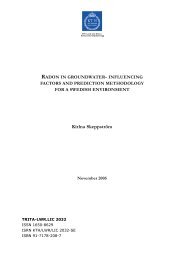Comparison between 1D and 2D models to analyze the dam break
Comparison between 1D and 2D models to analyze the dam break
Comparison between 1D and 2D models to analyze the dam break
- No tags were found...
You also want an ePaper? Increase the reach of your titles
YUMPU automatically turns print PDFs into web optimized ePapers that Google loves.
Ignacio Valcárcel LencinaTRITA LWR Masters Thesisnetwork <strong>and</strong> power supply etc. makes <strong>the</strong> situationespecially difficult for rescue operations. Thus <strong>the</strong>population in <strong>the</strong> danger area must be evacuatedbefore <strong>the</strong> arrival of a flood wave.The essential part of warning <strong>the</strong> population is <strong>to</strong> get<strong>the</strong> population <strong>to</strong> take <strong>the</strong> action necessary. Peoplemust be convinced of <strong>the</strong> reality of <strong>the</strong> danger <strong>and</strong><strong>the</strong>y must be advised <strong>to</strong> act according <strong>to</strong> <strong>the</strong>instructions of rescue authorities. A mere warning isoften not enough. People in danger need instructionson how <strong>to</strong> save <strong>the</strong>mselves from a threateningsituation.Definitely <strong>the</strong> most important fac<strong>to</strong>r affecting <strong>the</strong>warning, evacuation <strong>and</strong> rescuing of <strong>the</strong> localpopulation is <strong>the</strong> time period <strong>between</strong> <strong>dam</strong> failure <strong>and</strong>notification of <strong>the</strong> failure <strong>and</strong> commencement of <strong>the</strong>rescue operation. If a <strong>dam</strong> failure alarm is given late,<strong>the</strong> conditions for making emergency repairs <strong>to</strong> <strong>the</strong><strong>dam</strong> are poor <strong>and</strong> <strong>the</strong> probability of human casualtiesincreases.At <strong>the</strong> same time <strong>the</strong> benefit from <strong>the</strong> public alarmsystem installed <strong>to</strong> <strong>the</strong> <strong>dam</strong> danger area is lost. Thenotification speed of <strong>the</strong> <strong>dam</strong> failure has beenobserved <strong>to</strong> have a direct correlation <strong>to</strong> <strong>the</strong> loss ofhuman life (Douglas et al. 1999, Lemperiere 1999). Thesafety moni<strong>to</strong>ring of <strong>the</strong> <strong>dam</strong> must correspond <strong>to</strong> <strong>the</strong>risk fac<strong>to</strong>rs of <strong>the</strong> <strong>dam</strong>. The greater <strong>the</strong> failure risk of<strong>the</strong> <strong>dam</strong>, <strong>the</strong> greater <strong>the</strong> dem<strong>and</strong>s on <strong>dam</strong> safetymoni<strong>to</strong>ring functions.The credibility of following warning methods <strong>and</strong>achieving <strong>the</strong> necessary action was assessed:• public warning signals (sirens)• emergency bulletin on <strong>the</strong> radio• loudspeaker vehicles of rescue units• telephone <strong>and</strong> mobile phone (group calls)• warning people indoors from house <strong>to</strong>house.Public warning signals are best suited <strong>to</strong> urban areas,because an alarm can be given quickly <strong>and</strong> a largepopulation can be reached. The working state ofequipment is generally secured using backup batteries,<strong>to</strong> make sure <strong>the</strong> system is independent from anexternal power supply. Spoken messages <strong>and</strong>instructions can also be given using modern electronicequipment.One problem with public warning signals is <strong>the</strong>credibility fac<strong>to</strong>r – do people believe that <strong>the</strong> danger isreal. In addition <strong>to</strong> a public alarm signal, attentionmust be paid <strong>to</strong> <strong>the</strong> visibility of <strong>the</strong> warning.The success of a warning operation is partlydependent on <strong>the</strong> fact that <strong>the</strong> population is aware ofliving in a <strong>dam</strong> danger area. If a lot of people, whosesafety <strong>the</strong> rescue services cannot guarantee in case ofan emergency, are living in a <strong>dam</strong> danger area, anindependent initiative is also required for escaping <strong>the</strong>danger area. The population must be aware of <strong>the</strong>possible personal danger so that <strong>the</strong>y can protect<strong>the</strong>mselves <strong>and</strong> act on <strong>the</strong>ir own in case of anemergency. The necessary information can bedistributed through an advance information bulletin.This bulletin has a special purpose due <strong>to</strong> <strong>the</strong> nature ofa <strong>dam</strong> failure. In case of a chemical or radiationemergency, <strong>the</strong> population may be able <strong>to</strong> protect<strong>the</strong>mselves in <strong>the</strong>ir homes, but in case of a <strong>dam</strong> failure<strong>the</strong> situation is different. Some buildings fill with water<strong>and</strong> collapse due <strong>to</strong> structural strain of masses ofwater, whereas some buildings remain intact. Thebulletin is very important for <strong>the</strong> credibility of <strong>the</strong>warnings <strong>and</strong> decisions about action taken in a <strong>dam</strong>failure situation. The bulletin decreases <strong>the</strong> need for anindividual <strong>to</strong> find fur<strong>the</strong>r assurance of <strong>the</strong> threateningdanger <strong>and</strong> gives a prepared operational model forescaping <strong>the</strong> danger area.The purpose of warning <strong>and</strong> evacuation is <strong>to</strong> evacuateareas that will be flooded according <strong>to</strong> <strong>the</strong> inundationmaps. This applies in particular <strong>to</strong> buildings withoutupper s<strong>to</strong>reys. Rooms below ground must always beevacuated.Rescue authorities carry out evacuation in dangerareas. Taxis, local buses <strong>and</strong> ambulances are used asevacuation vehicles in <strong>the</strong> evacuation organised by <strong>the</strong>rescue authorities. If people living in <strong>the</strong> danger arealeave on <strong>the</strong>ir own, <strong>the</strong>y go on foot, use <strong>the</strong>ir ownvehicles or o<strong>the</strong>r means of transportation. Whenwarning <strong>and</strong> evacuating people, <strong>the</strong>y are instructed <strong>to</strong>take personal medication with <strong>the</strong>m.Vehicles used for evacuation are alerted <strong>to</strong> specifiedmeeting places by <strong>the</strong> emergency response centre.There drivers are given <strong>the</strong>ir tasks as well asinstructions <strong>and</strong> materials required <strong>to</strong> execute <strong>the</strong>tasks. Subsequently vehicles are sent <strong>to</strong> <strong>the</strong> evacuationareas <strong>to</strong> execute <strong>the</strong>ir evacuation tasks. Evacuationunits execute <strong>the</strong> evacuation under <strong>the</strong> supervision of<strong>the</strong> personnel of rescue services. Vehicles are not <strong>to</strong>proceed with <strong>the</strong> evacuation on <strong>the</strong>ir own, sincedrivers may have problems managing anxious peopleon <strong>the</strong>ir own.Evacuated people are taken <strong>to</strong> evacuation centres.These centres are organised by <strong>the</strong> social <strong>and</strong> healthservices using voluntary rescue service personnel. Thelocation of <strong>the</strong> evacuation centre must be planned sothat a <strong>dam</strong> failure does not have an effect on its water<strong>and</strong> heat supply, distribution of electricity <strong>and</strong> sewagesystem.The following supply services are organised in <strong>the</strong>evacuation centres:• first aid• crisis bulletin for evacuated people, <strong>the</strong>irfamilies <strong>and</strong> people who have lost <strong>the</strong>irhomes• psychosocial help for evacuated population<strong>and</strong> people who have lost family members orfriends• catering <strong>and</strong> clothing for evacuatedpopulation28
















